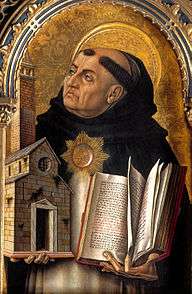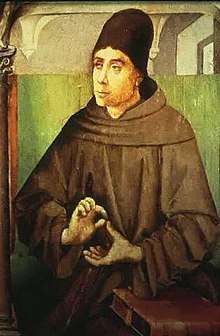Isidore of Seville
Isidore of Seville (/ˈɪzɪdɔːr/; Latin: Isidorus Hispalensis; c. 560 – 4 April 636), was a scholar and, for over three decades, Archbishop of Seville. He is widely regarded, in the oft-quoted words of the 19th-century historian Montalembert, as "the last scholar of the ancient world."[2]
Saint Isidore of Seville | |
|---|---|
 St. Isidore of Seville (1655), depicted by Bartolomé Esteban Murillo | |
| Bishop, Confessor, and Church Father | |
| Born | c. 560 Cartagena, Spania, Byzantine Empire |
| Died | 4 April 636 (aged 79–80) Seville, Visigothic Kingdom |
| Venerated in | Catholic Church Eastern Orthodox Church |
| Canonized | 653 by the Eighth Council of Toledo |
| Feast | 4 April |
| Attributes | Bees; Bishop holding a pen while surrounded by a swarm of bees; bishop standing near a beehive; old bishop with a prince at his feet; pen; priest or bishop with pen and book; with Saint Leander, Saint Fulgentius, and Saint Florentina; with his Etymologiae |
| Patronage | students, The Internet, computer users, computer technicians, programmers (all electronic patronages are unofficial)
Philosophy career |
Notable work | Etymologiae |
| Era | Medieval philosophy |
| School | Etymology Augustinianism[1] |
Main interests | grammar, rhetoric, mathematics, medicine, law, languages, cities, animals and birds, the physical world, geography. |
Notable ideas | Isidoran map |
Influences
| |
Influenced
| |
At a time of disintegration of classical culture,[3] and aristocratic violence and illiteracy, he was involved in the conversion of the Arian Visigothic kings to Catholicism, both assisting his brother Leander of Seville, and continuing after his brother's death. He was influential in the inner circle of Sisebut, Visigothic king of Hispania. Like Leander, he played a prominent role in the Councils of Toledo and Seville. The Visigothic legislation that resulted from these councils influenced the beginnings of representative government.
His fame after his death was based on his Etymologiae, an etymological encyclopedia which assembled extracts of many books from classical antiquity that would have otherwise been lost.
Life
Childhood and education
Isidore was born in Cartagena, Spain, a former Carthaginian colony, to Severianus and Theodora. Both Severianus and Theodora belonged to notable Hispano-Roman families of high social rank.[4] His parents were members of an influential family who were instrumental in the political-religious maneuvering that converted the Visigothic kings from Arianism to Catholicism. The Catholic Church celebrates him and all his siblings as known saints:
- An elder brother, Leander of Seville, immediately preceded Isidore as Archbishop of Seville and, while in office, opposed King Liuvigild.
- A younger brother, Fulgentius of Cartagena, served as the Bishop of Astigi at the start of the new reign of the Catholic King Reccared.
- His sister, Florentina of Cartagena, served God as a nun and allegedly ruled over forty convents and one thousand consecrated religious. This claim seems unlikely, however, given the few functioning monastic institutions in Iberia during her lifetime.[5]
Isidore received his elementary education in the Cathedral school of Seville. In this institution, the first of its kind in Iberia, a body of learned men including Archbishop Leander of Seville taught the trivium and quadrivium, the classic liberal arts. Isidore applied himself to study diligently enough that he quickly mastered Latin,[6] and acquired some Greek, and Hebrew.
Two centuries of Gothic control of Iberia incrementally suppressed the ancient institutions, classic learning, and manners of the Roman Empire. The associated culture entered a period of long-term decline. The ruling Visigoths nevertheless showed some respect for the outward trappings of Roman culture. Arianism meanwhile took deep root among the Visigoths as the form of Christianity that they received.
Scholars may debate whether Isidore ever personally embraced monastic life or affiliated with any religious order, but he undoubtedly esteemed the monks highly.
Bishop of Seville
_01.jpg)

After the death of Leander of Seville on 13 March 600 or 601, Isidore succeeded to the See of Seville. On his elevation to the episcopate, he immediately constituted himself as the protector of monks.
Isidore recognized that the spiritual and material welfare of the people of his See depended on the assimilation of remnant Roman and ruling barbarian cultures, and consequently attempted to weld the peoples and subcultures of the Visigothic kingdom into a united nation. He used all available religious resources toward this end and succeeded. Isidore practically eradicated the heresy of Arianism and completely stifled the new heresy of Acephali at its very outset. Archbishop Isidore strengthened religious discipline throughout his See.
Archbishop Isidore also used resources of education to counteract increasingly influential Gothic barbarism throughout his episcopal jurisdiction. His quickening spirit animated the educational movement centered on Seville. Isidore introduced Aristotle to his countrymen long before the Arabs studied Greek philosophy extensively.
In 619, Isidore of Seville pronounced anathema against any ecclesiastic who in any way should molest the monasteries.
Second Synod of Seville (November 619)
Isidore presided over the Second Council of Seville, begun on 13 November 619, in the reign of King Sisebut, a provincial council attended by eight other bishops, all from the ecclesiastical province of Baetica in southern Spain. The Acts of the Council fully set forth the nature of Christ, countering the conceptions of Gregory, a Syrian representing the heretical Acephali.
Third Synod of Seville (624)
Based on a few surviving canons found in the Pseudo-Isidorian Decretals, Isidore is known to have presided over an additional provincial council around 624.
The council dealt with a conflict over the See of Écija, and wrongfully stripped bishop Martianus of his see, a situation that was rectified by the Fourth Council of Toledo. It also addressed a concern over Jews who had been forced to convert to Christianity,.
The records of the council, unlike the First and Second Councils of Seville were not preserved in the Hispana, a collection of canons and decretals likely edited by Isidore himself.[7]
Fourth National Council of Toledo
All bishops of Hispania attended the Fourth National Council of Toledo, begun on 5 December 633. The aged Archbishop Isidore presided over its deliberations and originated most enactments of the council.
Through Isidore's influence, this Council of Toledo promulgated a decree commanding all bishops to establish seminaries in their cathedral cities along the lines of the cathedral school at Seville, which had educated Isidore decades earlier. The decree prescribed the study of Greek, Hebrew, and the liberal arts and encouraged interest in law and medicine.[8] The authority of the Council made this education policy obligatory upon all bishops of the Kingdom of the Visigoths. The council granted remarkable position and deference to the king of the Visigoths. The independent Church bound itself in allegiance to the acknowledged king; it said nothing of allegiance to the Bishop of Rome.
Death
Isidore of Seville died on 4 April 636 after serving more than 32 years as archbishop of Seville.
Work
Isidore's Latin style in the Etymologiae and elsewhere, though simple and lucid, reveals increasing local Visigothic traditions.
Etymologiae
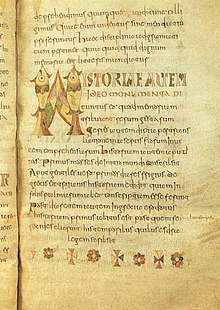

Isidore was the first Christian writer to try to compile a summa of universal knowledge, in his most important work, the Etymologiae (taking its title from the method he uncritically used in the transcription of his era's knowledge). It is also known by classicists as the Origines (the standard abbreviation being Orig). This encyclopedia – the first such Christian epitome – formed a huge compilation of 448 chapters in 20 volumes.[9]
In it, as Isidore entered his own terse digest of Roman handbooks, miscellanies and compendia, he continued the trend towards abridgements and summaries that had characterised Roman learning in Late Antiquity. In the process, many fragments of classical learning are preserved which otherwise would have been hopelessly lost; "in fact, in the majority of his works, including the Origines, he contributes little more than the mortar which connects excerpts from other authors, as if he was aware of his deficiencies and had more confidence in the stilus maiorum than his own" his translator Katherine Nell MacFarlane remarks.[10]
Some of these fragments were lost in the first place because Isidore's work was so highly regarded – Braulio called it quaecunque fere sciri debentur, "practically everything that it is necessary to know"[11] – that it superseded the use of many individual works of the classics themselves, which were not recopied and have therefore been lost: "all secular knowledge that was of use to the Christian scholar had been winnowed out and contained in one handy volume; the scholar need search no further".[12]
The fame of this work imparted a new impetus to encyclopedic writing, which bore abundant fruit in the subsequent centuries of the Middle Ages. It was the most popular compendium in medieval libraries. It was printed in at least ten editions between 1470 and 1530, showing Isidore's continued popularity in the Renaissance. Until the 12th century brought translations from Arabic sources, Isidore transmitted what western Europeans remembered of the works of Aristotle and other Greeks, although he understood only a limited amount of Greek.[13] The Etymologiae was much copied, particularly into medieval bestiaries.[14][15][16]
On the Catholic faith against the Jews
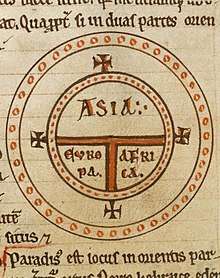
Isidore's De fide catholica contra Iudaeos furthers Augustine of Hippo's ideas on the Jewish presence in Christian society. Like Augustine, Isidore accepted the necessity of the Jewish presence because of their expected role in the anticipated Second Coming of Christ. In De fide catholica contra Iudaeos, Isidore exceeds the anti-rabbinic polemics of earlier theologians by criticizing Jewish practice as deliberately disingenuous.[17]
He contributed two decisions to the Fourth Council of Toledo: Canon 60 calling for the forced removal of children from parents practicing Crypto-Judaism and their education by Christians, and Canon 65 forbidding Jews and Christians of Jewish origin from holding public office.[18]
Other works
Isidore's authored more than a dozen major works on various topics including mathematics, holy scripture, and monastic life,[19] all in Latin:
- Historia de regibus Gothorum, Vandalorum et Suevorum, a history of the Gothic, Vandal and Suebi kings. The longer edition, issued in 624, includes the Laus Spaniae and the Laus Gothorum.
- Chronica Majora, a universal history
- De differentiis verborum, a brief theological treatise on the doctrine of the Trinity, the nature of Christ, of Paradise, angels, and men
- De natura rerum (On the Nature of Things), a book of astronomy and natural history dedicated to the Visigothic king Sisebut
- Questions on the Old Testament
- a mystical treatise on the allegorical meanings of numbers
- a number of brief letters
- Sententiae libri tres Codex Sang. 228; 9th century[20]
- De viris illustribus
- De ecclesiasticis officiis
- De summo bono
Veneration

Isidore was one of the last of the ancient Christian philosophers and was contemporary with Maximus the Confessor. He has been called the most learned man of his age by some scholars,[21][22] and he exercised a far-reaching and immeasurable influence on the educational life of the Middle Ages. His contemporary and friend, Braulio of Zaragoza, regarded him as a man raised up by God to save the Iberian peoples from the tidal wave of barbarism that threatened to inundate the ancient civilization of Hispania.[23]
The Eighth Council of Toledo (653) recorded its admiration of his character in these glowing terms: "The extraordinary doctor, the latest ornament of the Catholic Church, the most learned man of the latter ages, always to be named with reverence, Isidore". This tribute was endorsed by the Fifteenth Council of Toledo, held in 688, and later in 1598 by Pope Clement VIII. Isidore was declared a Doctor of the Church in 1722 by Pope Innocent XIII.
Isidore was interred in Seville. His tomb represented an important place of veneration for the Mozarabs during the centuries after the Arab conquest of Visigothic Hispania. In the middle of the 11th century, with the division of Al Andalus into taifas and the strengthening of the Christian holdings in the Iberian peninsula, Ferdinand I of León and Castile found himself in a position to extract tribute from the fractured Arab states. In addition to money, Abbad II al-Mu'tadid, the Abbadid ruler of Seville (1042–1069), agreed to turn over St. Isidore's remains to Ferdinand I.[24] A Catholic poet described al-Mutatid placing a brocaded cover over Isidore's sarcophagus, and remarked, "Now you are leaving here, revered Isidore. You know well how much your fame was mine!" Ferdinand had Isidore's remains reinterred in the then-recently constructed Basilica of San Isidoro in León. Today, many of his bones are buried in the cathedral of Murcia, Spain.
Legacy
In Dante's Paradiso (X.130), Isidore is mentioned among theologians and Doctors of the Church alongside the Scot Richard of St. Victor and the Englishman Bede the Venerable.
The University of Dayton has named their implementation of the Sakai Project in honour of Saint Isidore.[25]
His likeness, along with that of Leander of Sevile and Ferdinand III of Castile, is depicted on the crest badge of Sevilla FC.
The Order of St. Isidore of Seville is a chivalric order formed on January 1, 2000. An international organisation, the order aims to honour Saint Isidore as patron saint of the Internet, alongside promoting Christian chivalry online.[26][27]
Honours
St. Isidore Island in Antarctica is named after the saint.
See also
- Saint Isidore of Seville, patron saint archive
References
- Augustinianism
- Montalembert, Charles F. Les Moines d'Occident depuis Saint Benoît jusqu'à Saint Bernard [The Monks of the West from Saint Benoit to Saint Bernard]. Paris: J. Lecoffre, 1860.
- Jacques Fontaine, Isidore de Séville et la culture classique dans l'Espagne wisigothique (Paris) 1959
- Priscilla Throop, Isidore of Seville's Etymologies: Complete English Translation. Vermont: MedievalMS, 2005, p. xi.
- Roger Collins, Early Medieval Spain. New York: St Martin's Press, 1995, pp. 79–86.
- "His literary style, though lucid, is pedestrian": Katherine Nell MacFarlane's observation, in "Isidore of Seville on the Pagan Gods (Origines VIII. 11)", Transactions of the American Philosophical Society, New Series, 70.3 (1980):1–40, p. 4, reflects mainstream secular opinion.
- Rachel Stocking, "Martianus, Aventius and Isidore: provincial councils in seventh-century Spain" Early Medieval Europe 6 (1997) 169–188.
- Isidore's own work regarding medicine is examined by Sharpe, William D. (1964). "Isidore of Seville: The Medical Writings". Transactions of the American Philosophical Society. 54 (2).
- MacFarlane 1980:4; MacFarlane translates Etymologiae viii.
- MacFarlane 1980:4; MacFarlane translates Etymologiae viii.
- Braulio, Elogium of Isidore appended to Isidore's De viris illustribus, heavily indebted itself to Jerome.
- MacFarlane 1980:4.
- "CATHOLIC ENCYCLOPEDIA: St. Isidore of Seville". www.newadvent.org. Retrieved 27 July 2020.
- Verner, Lisa (2005). The Epistemology of the Monstrous in the Middle Ages. Routledge. pp. 94–95. ISBN 978-0-415-97243-7.
- Green, Roland, ed. (2012). The Princeton Encyclopedia of Poetry and Poetics (4th ed.). Princeton University Press. ISBN 9780691154916.
- Barber, Richard W. (1992). Bestiary : Being an English Version of the Bodleian Library, Oxford M.S. Bodley 764: With All the Original Miniatures Reproduced in Facsimile. Woodbridge, Suffolk, England: Boydell & Brewer. pp. 8, 13.
- Cohen, Jeremy (1999). Living Letters of the Law. Berkeley: University of California Press. p. 97. ISBN 978-0-520-21870-3 – via books.google.com.
- Bar-Shava Albert (1990). "Isidore of Seville: His attitude towards Judaism and his impact on early Medieval Canonical law". The Jewish Quarterly Review. XXX 3,4 (3/4): 207–220. JSTOR 1454969.
- Christopher Lowney (4 December 2012). A Vanished World: Medieval Spain's Golden Age of Enlightenment. Simon and Schuster. pp. 17–. ISBN 978-0-7432-8261-1.
- "e-codices – Virtuelle Handschriftenbibliothek der Schweiz". www.e-codices.unifr.ch. Retrieved 27 July 2020.
- Isidore of Seville; Translator: Dennis D. McManus; Raúl Gómez-Ruiz (2008). "Introduction". In Dennis D. McManus (ed.). Isidore of Seville: De Ecclesiasticis Officiis. Paulist Press. p. 11. ISBN 978-0-8091-0581-6.
- Bradford Lee Eden (2 August 2004). "Isidore of Seville". In Christopher Kleinhenz; John W. Barker; Gail Geiger; Richard Lansing (eds.). Medieval Italy: An Encyclopedia. Taylor & Francis. p. 2012. ISBN 978-1-135-94879-5.
- Jorge Mario Cabrera Valverde (2004). Estampas de la Antigüedad Clásica. Editorial Universidad de Costa Rica. p. 124. ISBN 978-9977-67-803-0.
Un discípulo suyo, San Braulio de Zaragoza, escribe sobre él: ""Después de tantas ruinas y desastres, Dios le ha suscitado en estos últimos tiempos para restaurar los monumentos de los antiguos, a fin de que no cayésemos por completo en la barbarie." English: A disciple of his, San Braulio de Zaragoza, writes about him: After so much destruction and so many disasters, God has raised him in recent times to restore the monuments of the ancients, so that we would not fall completely into barbarism.
- Father Alban Butler. "Saint Isidore, Bishop of Seville". Lives of the Fathers, Martyrs, and Principal Saints, 1866. Saints.SQPN.com. 2 April 2013. Web. 9 August 2014. Saints SQPN
- "Isidore - Redirecting to /portal". isidore.udayton.edu. Retrieved 27 July 2020.
- Tom Chatfield (2 August 2016). Netymology: From Apps to Zombies: A Linguistic Celebration of the Digital World. Quercus. p. 171. ISBN 978-1-62365-165-7.
- Jack Lynch (23 February 2016). You Could Look It Up: The Reference Shelf From Ancient Babylon to Wikipedia. Bloomsbury Publishing. p. 82. ISBN 978-0-8027-7794-2.
Primary sources
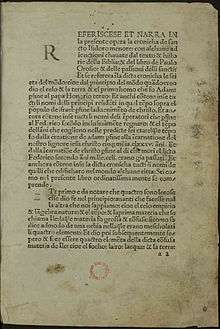
- The Etymologiae (complete Latin text)
- Barney, Stephen A., Lewis, W.J., Beach, J.A. and Berghof, Oliver (translators). The Etymologies of Isidore of Seville. Cambridge: Cambridge University Press, 2006. ISBN 0-521-83749-9, 978-0-521-83749-1.
- Ziolkowski, Vernon P., The De Fide Catholica contra Iudaeos of Saint Isidorus, Bishop, Book 1, Saint Louis University, PhD diss. (1982).
- Castro Caridad, Eva and Peña Fernández, Francisco (translators). "Isidoro de Sevilla. Sobre la fe católica contra los judíos". Sevilla: Universidad de Sevilla, 2012. ISBN 978-84-472-1432-7.
- Throop, Priscilla, (translator). Isidore of Seville's Etymologies. Charlotte, VT: MedievalMS, 2005, 2 vols. ISBN 1-4116-6523-6, 978-1-4116-6523-1, 1-4116-6526-0
- Throop, Priscilla, (translator). Isidore's Synonyms and Differences. (a translation of Synonyms or Lamentations of a Sinful Soul, Book of Differences I, and Book of Differences II) Charlotte, VT: MedievalMS, 2012 (EPub ISBN 978-1-105-82667-2)
- Online Galleries, History of Science Collections, University of Oklahoma Libraries High resolution images of works by Isidore of Seville in .jpg and .tiff format.
- De natura rerum (Msc.Nat.1) (On the Nature of Things) digitized by the Staatsbibliothek Bamberg.
- Lewis E 136 Carta pisana; Sententiae (Sentences) at OPenn
- Lewis E 137 Sententiae (Sentences) at OPenn
- MS 484/18 Quaestiones in josue, judicum, regum, machabeis at OPenn
Secondary sources
- Henderson, John. The Medieval World of Isidore of Seville: Truth from Words. Cambridge: Cambridge University Press, 2007. ISBN 0-521-86740-1.
- Herren, Michael. "On the Earliest Irish Acquaintance with Isidore of Seville." Visigothic Spain: New Approaches. James, Edward (ed). Oxford: Oxford University Press, 1980. ISBN 0-19-822543-1.
- Englisch, Brigitte. "Die Artes liberales im frühen Mittelalter." Stuttgart, 1994.

- . Dictionary of Christian Biography and Literature to the End of the Sixth Century (3rd ed.). 1911.
- "Isidore of Seville". Encyclopædia Britannica. 14 (11th ed.). 1911. pp. 871–872.
- O'Connor, J.B. (1910). "St. Isidore of Seville". Catholic Encyclopedia. 8.
Other material
- The Order of Saint Isidore of Seville, st-isidore.org
- Jones, Peter. "Patron saint of the internet", telegraph.co.uk, 27 August 2006 (Review of The Etymologies of Isidore of Seville, Cambridge University Press, 2006)
- Shachtman, Noah. "Searchin' for the Surfer's Saint", wired.com, 25 January 2002
External links


